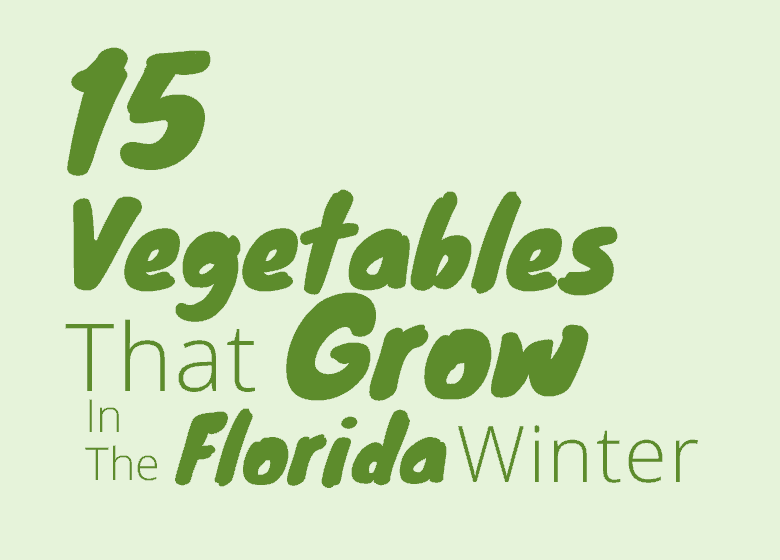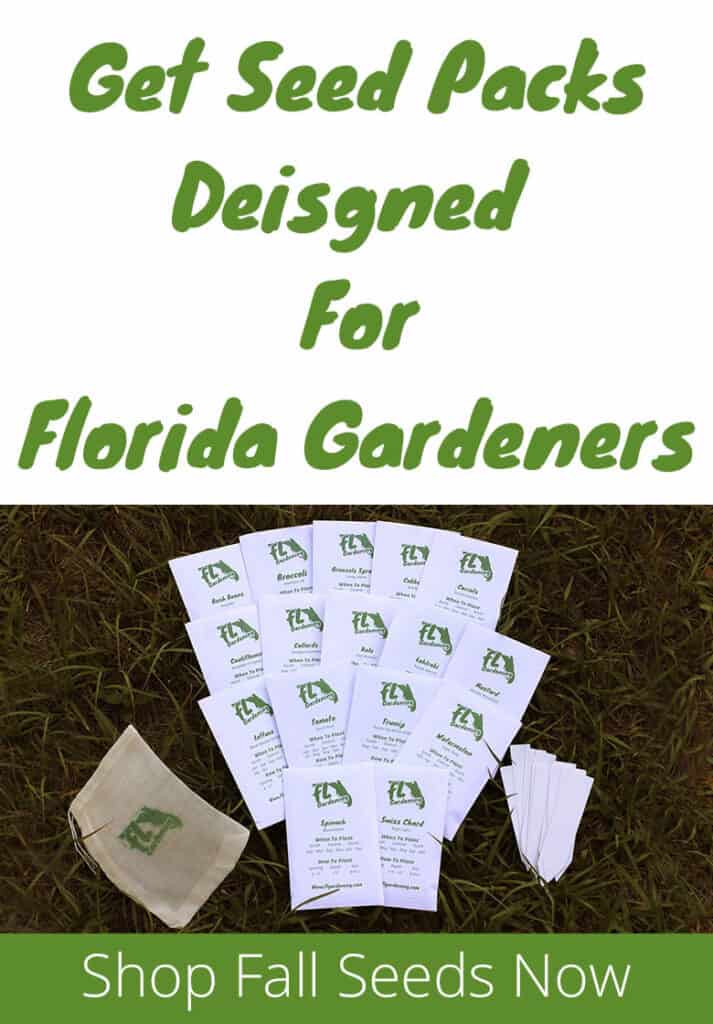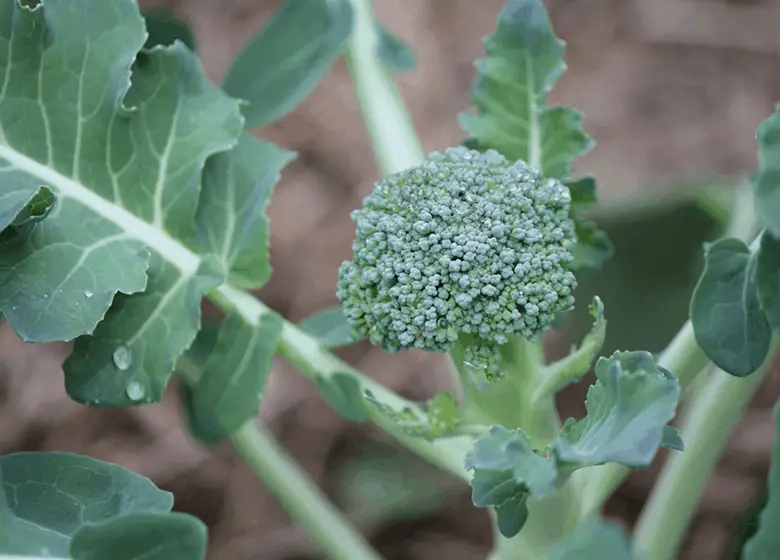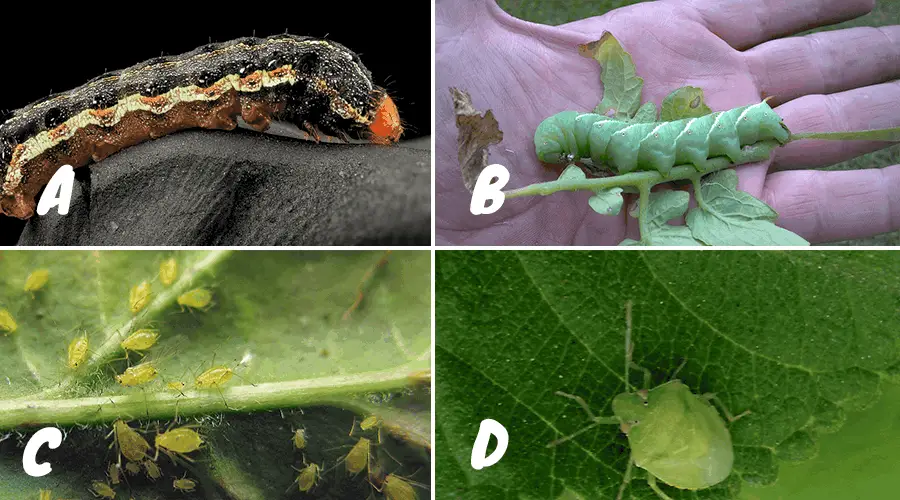
Vegetable gardening in the winter time for most parts of the united states seems difficult.
Not in Florida.
There are lots of vegetables that grow in the Florida winter. Arugula, Beets, Broccoli, Brussels Sprouts, Cabbage, Carrots, Cauliflower, Kale, Kohlrabi, Lettuce, Mustard, Radish, Spinach, Swiss Chard and Turnips can all grow in the Florida winter.
North Florida has a legitimate winter, they have nights in the upper teens a few nights a year. some parts of central Florida see frosts and rarely freezing temperatures while south Florida normally doesn’t see frost conditions, although it does happen sometimes.
Each part of the state will have slightly different planting times in order to maximize the ideal growing conditions for these veggies.

Vegetables That Grow In The Florida Winter
The coldest months in Florida are December, January, and February. Some of the vegetables on this list can withstand a north Florida winter. things like kale, Cauliflower, Carrots, and Chard can all survive freezing temperatures but not every single veggie on this list can withstand this.
those in North Florida and some parts of central Florida should make note of that. If you’re not sure what the average low temperature in your area is you can find that out here.
Arugula
Spicy spinach as I like to call it. Arugula can tolerate light frosts. Plant arugula in north and central Florida in September and in south Florida you can plant in October.
You can grow arugula all the way through march in all parts of the state. Arugula is a fast growing crop and can be harvested in about a month from planting.
Florida Friendly Arugula Varieties: Astro, Speedy
It’s best to spread out your plantings of arugula by 2 to 3 weeks. This lets you have a continuous harvest of fresh arugula. Each plant needs about 6 inches of space in order to grow to a nice size.
Beets
Beets love to grow in the Florida winter. Starting beets from seed is probably the hardest part of growing them. Our cool winters give the seedlings a better chance of getting established.
Beets can be grown in warm weather as well as cool weather. They are a versatile vegetable that can withstand a hard freeze. Plant beets in North and Central Florida during September and in South Florida you can plant in October.
Florida Friendly Beet Varieties: Cylindra, Detroit Dark Red, Early Wonder, Tall Top, Yellow Detroit
Beets can be grown throughout the Florida winter all the way into early spring. March marks the end of the growing season for beets. Beets usually mature in about 2 months from planting.
Ensure you thin seedlings to give each plant about 3 inches of space all the way around to grow.
For more info on growing beets in Florida check out this post.
Broccoli
Broccoli can tolerate freezing temperatures which means that those in north Florida can grow this vegetable in the winter time. It is one of the easiervegetables to start from seed.

Those in North and central Florida should plant in September. Those in South Florida should plant in October. You can grow broccoli all the way through until March.
Florida Friendly Broccoli Varieties: Calabrese, De Cico, Early Dividend, Early Green, Packman, Waltham
Harvest broccoli heads before their flowers open. After you harvest the first head of broccoli the plant will send out more side shoots that you can harvest.
For more on growing broccoli in Florida check out this post.
Brussels Sprouts
A slow maturing, cool season crop which may be difficult for those in some parts of South and Central Florida. Brussels can take up to 140 days in order to mature and don’t like overly warm weather.
Warm weather causes the little tiny heads of cabbage to open up and taste bad.
Florida Friendly Brussels Sprout Varieties:Jade Cross, Long Island Improved
In North Florida you should plant your seeds in August. In Central Florida you should plant in September and those in South Florida Should plant in October.
Give each plant about 2 feet of space all the way around to grow. They can grow large, up to 3 feet tall but actually do not require staking.
Cabbage
Frost tolerant and not picky, it’s probably one of the easier vegetables to grow in the Florida winter. Cabbage hates warm weather and will begin to bolt at the first sign of the temperatures heating up.
Cabbages take about 3 months in order to mature. It’s a good idea to space out planting a little bit in order to have a continuous harvest.
Florida Friendly Cabbage Varieties: Copenhagen Market, Flat Dutch, Red Acre, Rio Verde, Round Dutch, Savoy, Wakefield
Plant cabbage in all parts of the state around September in full sun. Cabbage really benefits from being fertilized with a nitrogen heavy fertilizer.
The only issue that I’ve had when growing cabbage is armyworms, they cut down my cabbages when they were tiny seedlings. But I’ll have more on common pests later in this post.
Carrots
The hardest part about growing carrots for me has been getting the seeds to start. They’re really tiny seeds and they must stay moist in order to sprout and they can take up to 3 weeks to show their little heads.
In all parts of Florida you can plant carrots from September to March. Space out your planting times in order to have a continous harvest of carrots.
Florida Friendly Carrot Varieties: Chantenay, Danvers, Nantes, Imperator
It’s important to thin your carrot seedlings out to give them enough room to grow. Carrots like about 2 inches of space to spread their roots. They usually take about 2 months in order to mature and they also like loose soil.
Cauliflower
Cauliflower can withstand moderate frosts but can not take freeing temperatures. Those in North Florida and some parts of Central Florida should be mindful of this.
In all parts of the state you should plant cauliflower seeds in the garden around September. The growing season comes to an end around March.
Florida Friendly Cauliflower Varieties: Brocoverde, Snowball, Snow Crown
Cauliflower plants need about 18 inaches of space all the way around in order to fully mature. Plant in an area that gets full sun. Be sure to water regularly and treat with a nitrogen heavy fertilizer.
For more info on growing cauliflower in Florida check out this post.
Collards

One of the easiest vegetables to grow in the Florida winter and the Florida summer. Collard greens are an amazing vegetable. they can take our summer heat and can withstand hard frosts.
When grown in the cold weather, the leaves of the plant are much more flavorful. Plant collards around August and September for all parts of the state.
Florida Friendly Collard Varieties: Georgia Southern, Top Bunch, Vates
Collards do well when fertilized with a nitrogen focused fertilizer and are ready for harvest about 2 months after planting.
For more info on growing collards in Florida check out this post.
Kale
Kale tastes the best when grown through light frosts. The cold weather sweetens up the taste of the leaves. Kale can withstand even the coldest night the North Florida winter can throw at it.
Plant kale around September for all parts of the state. It can be grown throughout the winter time all the way until April when the weather begins to warm.
Florida friendly Kale Varieties: Tuscan(lacinato), Red Russian, Redbor, Vates Dwarf Blue Curled, Winterbor
Give kale full sun and about a foot and a half of space per plant. You can begin to harvest kale about 2 months after planting.
Kohlrabi
An alien looking plant that loves the cold weather. It’s not the most common plant to have in your garden but it is eye-catching. In german, its name translates to cabbage turnip.
Plant Kohlrabi in all parts of the state around September. You can continue growing until March. It’s easy to grow and comes in both red and green varieties.
Florida Friendly Kohlrabi Varieties:Early White Vienna, Early Purple Vienna, Grand Duke, Kolibri, Superschmelz
Kohlrabi matures quickly, in about 2 months. You can harvest the root and also the leaves. Both parts of the plant are edible. Kohlrabi is a large plant and needs about 2 feet of space in order to fully mature.
Lettuce
Lettuce can mean a lot of different plants. However, all of them enjoy our Florida winters.
You have 4 different types to choose from. Crisphead, Butter, Looseleaf and Romaine. Crisphead lettuce is basically iceberg lettuce (and probably the most difficult one to grow out of all the lettuces).
Florida Friendly Lettuce Varieties:
- Butter: Bib, Buttercrunch, Ermosa, Tom Thumb
- Crisphead: Great Lakes
- Loose Leaf: New Red Fire, Oak Leaf, Red Sails, Royal Oak, Salad Bowl, Simpson
- Romaine: Parris Island Cos, Outredgeous
Lettuce can be planted in all parts of the state September through February. If grown in conditions that are too warm your lettuce will begin to taste bitter. But lettuce will not survive any hard frosts. This is easy to avoid though because lettuce is a fast growing crop.
You can harvest lettuce about 2 months after planting. This is another plant where it is a good idea to space out planting. This way you can constantly have a supply of fresh leaves.
I wrote an article all about growing lettuce in Florida which you can check out here.
Mustard
Mustard is pretty similar to collards in terms of growing them. The two might be tied for the easiest vegetable to grow in Florida. They are versatile in which they can be grown pretty much year round, they can take the chills and the heat Florida has to offer.
The best time to plant for Florida is September. The cooler months will allow the leaves to develop the best flavor.
Florida Friendly Mustard Varieties: Florida Broad Leaf, Giant Red, Green Wave, Mizuna, Southern Giant Curled, Tendergreen
Just like lettuce warm weather causes mustard to bolt and become bitter tasting. Mustard is a fast growing food, usually ready for harvest in about 45 days.
When growing be sure to give each mustard plant about a foot and a half of space all the way around.
Radish
A radish can really spice up a boring salad quick. This may be a less popular vegetable on this list but it is a fast and easy vegetable to grow.
Radishes are frost tolerant and if grown in warmer weather they will producer a spicer tasting root. In north Florida, you can actually begin planting in April all the way through to November. In central and south Florida you can plant from October to April.
Florida Friendly Radish Varieties: Champion Cherry Belle, Daikon, Sparkler, White Icicle
Radish plants only need 2 to 3 inches of space in order to grow. They mature fast, usually ready for harvest in about 45 days.
I’ve also written an article on growing radishes in Florida, which you can check out here.
Spinach
Spinach produces the best-tasting leaves only in the coolest months of the year for us. Like other lettuce type crops, bolting occurs when the weather warms up. Although Malabar spinach(not a true spinach) actually prefers the warmth. But that’s a whole different topic.
Plant spinach, in full sun, during October in all parts of the state.
Florida Friendly Spinach Varieties: Bloomsdale Longstanding, Melody 3, Space, Tyee
Spinach usually matures in 2 months from planting. Spinach is best grown from seeds directly planted into the garden. Give each plant about 6 inches of room to spread their roots and leaves.
Swiss Chard
Swiss chard can withstand a moderate freeze and usually takes just under 2 months in order to grow large enough to begin harvesting. Chard is a bright leafy green that adds a splash of color to your green garden.
In all parts of Florida you should plant around October and you can keep growing from then until almost May. Hard North Florida freezes will knock this plant back but because it matures so quickly you shouldn’t have a problem waiting until those cold few weeks roll out and plant again.
Florida Friendly Varieties: Bright Lights, Bright Yellow, Fordhook Giant, Lucullus, Ruby Red
Like all of the fast growing crops, make sure you plant more every few weeks to ensure you have a constant supply of fresh chard on its way.
Turnips
The last fast growing cool season crop on this list! Both the roots and the green leaves of turnips are edible. Another less popular vegetable that I think gets undated.
Turnips can withstand light frosts as well as warmer weather. Those in central Florida would probably be able to plant these seeds year round but will get better results in the cooler months. In North Florida, you should plant in August through October and then again in January. Those in South Florida should plant in October.
Florida Friendly Turnip Varieties: Purple Top White Globe, Seven Top, Shogoin
Directly plant turnip seeds in the garden in a spot that gets full sun. Thin seedlings out as they pop up in order to give each plant about 3 inches of space. Turnips are root crops and prefer a soil that is loose in order to spread their roots easier.
Best Soil For Vegetables
There are a few vegetables on this list that can actualyl grow directly in the Florida soil. Things like Mustard and collards may not need any soil ammending but it is never a bad idea to add compost and a thick layer of mulch to your soil.
If planting directly into your Florida dirt, I would at the very least recommend adding those two things. Compost and mulch will go a long way. I’m a big fan of adding worm castings and Mykos to my dirt as well.
When I build soil for potted plants or raised bed I usually have really good luck with a mix that looks something like this:
- 40% Peat moss (Check price on Amazon)
- 40% Compost (You can get it on Amazon but I’ve found it way cheaper at local stores)
- 20% perlite (Check price on Amazon)
- Worm castings (Check price on Amazon)
- Mykos (Check price on Amazon)
Lately, I’ve been using Coco coir (Check price on amazon) instead of peat moss because it is more sustainable and it is less acidic.
Most of this stuff can be found at your local box store or nursery. The only things you may have trouble finding are the worm casting and the Mykos. Worm casting adds an extra nutrient boost and the Mykos is a beneficial Fungus that helps your plants absorb those nutrients.
Fertilizing Vegetables
Fertilizer bags that you see at the store most likely have 3 different numbers on them. These are the N-P-K values. Nitrogen(N), Phosphorus(P), Potassium(K).
Each nutrient does something different for your plant. Nitrogen helps promote green leafy growth. Phosphorus helps the plant produce healthy roots and plenty of flowers. Potassium is a good overall health booster, helping the plant with numerous functions.
So depending on what kind of harvest you have, you will want to alter your fertilizer. For instance, the main harvest on collards are their green leafy growth. You would want to use a fertilizer that is high in nitrogen to boost your yield.
while plants like carrots and radishes are used mostly for their roots. Your fertilizer would be better to have more phosphorus in order to increase your yield.
Common Florida Vegetable Pests
The most common pests you will see when growing vegetables in the Florida winter are Aphids and caterpillars.

There are a number of other pests you might come across (Leafminers, thrips, and whiteflies) but I think these two are by far the most common. This is what I’ve noticed from my personal experience anyway.
Thankfully these are easy to take care of. The best way to stop these pests from attacking your garden is to plant things that attract good bugs to your garden. Things like herbs and flowers will bring biodiversity to your garden.
A biodiverse garden is a happy garden. For more on attracting beneficial plants to your Florida garden check this post out.
However, sometimes there is a need for chemical action. There are two organic sprays that will take care of aphids and caterpillars. These are neem oil and B.t. Check these out with some other pest control measures here.
Growing Vegetables During The Florida Winter
- 15 Vegetables the grow in the Florida winter are Arugula, Beets, Broccoli, Brussels Sprouts, Cabbage, Carrots, Cauliflower, Kale, Kohlrabi, Lettuce, Mustard, Radish, Spinach, Swiss Chard and Turnips.
- The coldest months in Florida are December January and February.
- Planting times for the Florida winter time are usually around September and October.
- Most of the vegetables that are grown in the Florida winter are root crops and leafy greens.
- Build good soil, provide full sun and adequate water and you should have no problem growing these vegetables in the Florida winter.
